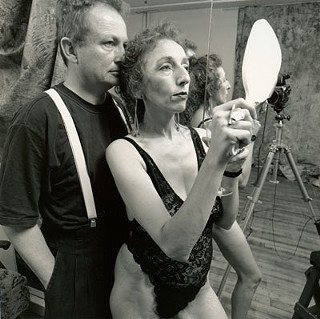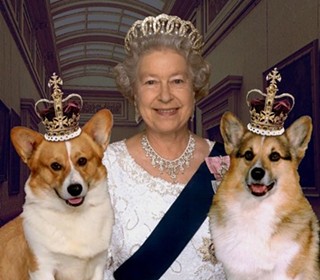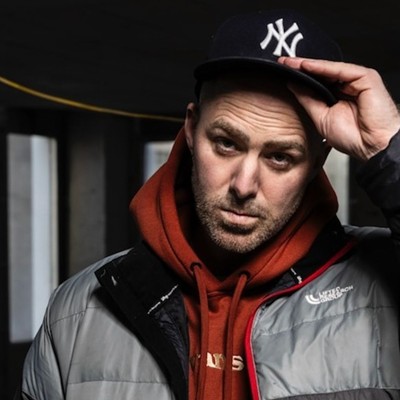George Steeves calls his house the photo bunker. It’s well hidden, deep on a looping crescent in an old Clayton Park neighbourhood—it was the end of town when Steeves moved there in 1973—where bungalows protectively stretch out like arms linking in solidarity.
The photo bunker is built on angles and soft watery colours. It’s tidy, but the wooden posts that hold up the covered car-park jut out like they’re trying to escape. Expecting a modern-day Henry Miller, Steeves has aged slightly from the 78 photographs that will be on exhibition at Mount Saint Vincent University Art Gallery starting February 28—but there’s no mistaking the eyes, which stare intently from behind fashionably round frames.
Inside, paintings from artist Susan Rome—Steeves’ former model and ex-wife—hang throughout the house. A large metal Canadian coat of arms, dominant on the living room fireplace, is recognizable from a 1999 self-portrait. In it, Steeves stands in front of the fireplace wearing a stretched woman’s lace top and panties, a crucifix forming a perfect V in front of his penis, Jesus’s tiny feet resting on top of the screen. If we’ve learned anything from pop singer Madonna, it’s that lace, sexuality and religious symbols are a potent mix of controversy, which may be why this internationally received artist has never been fully accepted in his own town.
Almost every room has at least one floor-to-ceiling locker-style cabinet containing over 30 years of photographic work. In the dining room, he points out where the floor is slightly buckling from the weight. Still, with a little information, Steeves can quickly find any image on request, either of his own, or from his extensive library of photography books.
“A photographer is only as good as his visual memory,” he says. Steeves speaks with an unidentifiable drawl, and chooses his words carefully. An engineer by training, he retired last year from the Bedford Institute of Oceanography, and his life appears to be ruled by architected order. In the 1970s Steeves taught himself photography, lugging around a heavy 8x10 view camera, shooting landscapes and learning about 19th-century printing processes. “The technicalities of the thing weren’t difficult because I had a technical training, but I had to teach myself the art history and the aesthetic past of photography.”
The spacious basement studio is meticulously organized. Pencils are sharpened to perfect points, archival boxes labelled and neatly stacked. Down the hall is Steeves’ well-equipped professional darkroom, where he starts work on Saturdays at 4:30am. The flooring was replaced from his worn path. With years spent in the darkroom comes masterful expertise of development processes and chemical formulas—some of his photos include up to seven different exposures.
Perhaps Steeves would have continued shooting landscapes if, in 1981, he hadn’t been introduced to performance artist Ellen Pierce at the MSVU Art Gallery. “I met her in that back room. On this occasion it was a dressing room. So I’m in there chatting with her and she’s in this costume, a fur coat and evening gown, and she just strips this off and changes. I thought she was fantastic.”
Steeves fell in love with Pierce, who inspired the series Pictures of Ellen, first documenting her performances, then moving to more intimate portraits such as “Awful Morning, Marlborough St.,” where a naked Pierce, shot from mid-breast up, looks away; perhaps she woke up devastated, or simply tired. Like many of Steeves’ portraits, it’s a moment of stolen intimacy, of uncomfortable voyeurism.
In fact, what makes Steeves’ portrait shots so difficult to view is his subjects’ fearlessness in exposing themselves, not just physically (occasionally in unattractive poses), but in their vulnerabilities. His models over the years are mostly artists like Mary-Colin Chisholm, Mary Ellen MacLean, George Stamos, Sherry Lee Hunter, Tim Dunn and most significantly, Pierce, Astrid Brunner and Liane Heller—less flat subjects than creative partners.
“Some people are very interesting, they have their qualities, but you could only really shoot with them one or twice,” says Steeves. “They don’t want to develop that particular side of themselves for the camera. Too private. So certain people make natural collaborators and you go the distance with those people.”
Distance, yes. Steeves’ photos push boundaries. Often set in homes, the juxtaposition of plants, cheery tablecloths and tchotchkes mixed with sexually posed un-Hollywood naked bodies—shot with operatic detail and layers of historical and mythological references—feels like peeking at your neighbour’s private fantasies. In fact, Steeves says that the series Excavations is about digging up personal truths: “Things people purposely hide, embarrassing personal things they wouldn’t tell very many people, if anyone.” Many photos emerged from private conversations. “It wasn’t a re-enactment, it just set the tone. Like if you had an abortion and didn’t tell anyone. If you had a relationship with somebody and didn’t level with them elements of your past.”
Perhaps the uneasy power of Steeves’ photos comes from his intense involvement with his subjects—he knows them “very, very well. I spent far more time drinking and talking and interacting about personal problems with these people than I did shooting. So when I go to use the camera, I have a great deal of intimate knowledge about these people that informs. These aren’t people I walk away from after I take my shots.”
There’s a cathartic air in some of Steeves’ own appearances—posed either alone or with others—naked, in silk stockings, lipstick smeared, reflected in mirrors. He says, “It got to be more pronounced as life experience got to be more crushing and I wanted to record myself in these extreme situations. And I needed certain things done that couldn’t get anyone else to do.”
In one photo, Steeves stands in front of an open door. It’s winter, he’s perched on the balls of his feet, wearing only dark underwear. A gun cocked in hand. “I was over in PEI nursing my father to his death—he had cancer—and I was on the road for most of the year. That was New Year’s Day, 2000, he was in the hospital near the end. That was his gun, his house and I was feeling that way about things, looking after him, being the guardian, New Year’s Day, 2000.”
If George Steeves’ habitat is water, Astrid Brunner’s is represented by fire. Her crooked south-end house is easy to find, thanks to its amethyst-coloured exterior. The fragrance of sweet smoke clings from a wood stove in the middle of the room. A bottle of Valpolicella is uncorked for sharing. Her companion Aschi, a diminutive older Swiss man, wearing a winter hat with ear flaps and an cheerful gauzy scarf, sits by the stove, reading a translated version of Harry Potter.
While Steeves dresses monochromatically, Brunner is a flash of colour. Bright red hair curls over a sparkling headband, even her earrings move dramatically. Life is uncertain—Aschi, an unapologetic smoker, was diagnosed with cancer on January 23, and now must return to Switzerland for medical care. Still, Brunner is more than happy to talk about Steeves, or GS as she affectionately calls him, the man she credits for “saving her soul.”
Sitting at her kitchen table, Brunner says, “I’ve always written and I’ve always lived but I was always shy. It might not look like that now, but I really was. By his photographing me, and I looked at so many pictures of myself, that made me understand and accept who I was. It freed me for writing.”
While Steeves claims that Brunner asked him for over two years to shoot her, she remembers it differently. It was 1984 and Brunner was eating dinner at a downtown cafe. “I was sitting there all night long—and GS has this way of staring at you—and I was really embarrassed. I was wondering, ‘What does this man want?’” The two were introduced by the late Joe Sherman, editor of Arts Atlantic. “Either way, I did want to be photographed by him. I knew there was something there. And I don’t regret it.”
The two began shooting on November 11, 1987. Steeves set a schedule, at least once a month. “GS is very exact. He has all the dates, everything worked out. He brings the props. I would just say, ‘Tell me what to do’ and I would do it, but I never really had any concept. It became almost antiphonal. He would sound a tune and I would respond.”
The photos are an emotional testament to a volatile life. Brunner drinks wine, stares defiantly into the camera, sitting on a toilet in a black dress, breasts exposed. In another, she leans back, eyes closed in pleasure, her white dress pulled up to reveal a masked companion between her legs. Sometimes Steeves would push Brunner, who prefers wine to exercise, into physically strenuous positions to achieve a desired facial expression. Brunner, who at the time was working as an arts journalist and completing her PhD, says that posing gave her the courage to write creative fiction, and to start her own company, AB collector publishing. Her first book Glass, was written with the photos in mind.
“We’ve never been able to convince people that we’re not lovers,” Brunner says. “We’ve never actually slept together and we don’t want to sleep together. We’ve drunk a lot—we could have done it—and I probably would have enjoyed it. It’s not that kind of relationship. That enabled me to do things in front of the camera that if I slept with him or loved him in that way, I probably couldn’t have done. I think it would have changed. If you look at the photos I think you can see that.”
Although the two still meet for the occasional shoot, most of their interactions these days don’t involve the camera. “We’ve been getting to know each other in other ways—social ways and intimate ways. We’re for life. Death do us part in that sense.
“And,” Brunner says, laughing, imitating Marlene Dietrich, “I’m photographed to death.”
Wind is Lianne Heller’s natural element, a nod to her nomadic past, her halo of pale hair. Heller was born in Paris, grew up in New York and Montreal, lived in many places before settling in Halifax.
It’s Friday night and she’s just finished her shift as a copy editor. The late hours give Heller, who peppers conversation with quotes from Emily Dickinson, time to write. She’s working on a series of 78 poems to accompany each photo in Steeves’ Excavations series. Her first book, Exposures, published by Brunner, is an extended collaborative tribute to Steeves’ photos, which appear alongside the poems. There’s a sense of singular focus, perhaps obsession, with her longtime creative partner.
Throughout her upper-flat apartment, there are paintings by sister Susanna Heller and Steeves’ photographs—including a striking one of a frozen apple tree swollen with fruit. There’s one of Steeves sitting outside, arm stretched up, as Heller perches her chin on his knuckles, her arms in mid-flight.
“I didn’t really like him at first, I thought he was kind of spooky,” says Heller, smoking a cigarette. “I looked at this catalogue, of these photos of him in drag. And he wasn’t gay. It would have been fine if he was, but he wasn’t. I didn’t know what to make of him. So I stayed away. But I was fascinated with him.”
They met through Heller’s husband Tim Dunn. Steeves first saw Dunn when he was a “human prop” for dancer Marise Vachon, hanging upside down, wearing nothing but anti-gravity boots. Afterward, Steeves wrote Dunn a long letter and Dunn began posing for him.
On Halloween night 1996, Steeves invited the couple for dinner. When they arrived, Steeves had laid out a beautiful golden gown from Neptune Theatre for Heller. She says, “It was long and floaty and romantic and I thought, ‘I can’t wear that.’ But it was like dressing up with my sister and playing Swan Lake or Nutcracker. Digging into my grandmother’s beautiful, old costumes—she was a stage performer and a singer.”
Steeves laced up the dress for her. “I caught his eye in the mirror as this was happening, and there was this instant understanding of seeing,” says Heller. “Seeing through, not just in a flat magazine way—it wasn’t Vanity Fair or Annie Leibowitz—it was a recognition of a certain awed transfiguring way of looking at the world and oneself. I felt like it was magic. Like a fairytale. I could be this transformed person, not only in the privacy of my own mind.”
As with Brunner, their first shoot was on November 11, and the duo have worked together ever since. Many of Steeves’ most photographically experimental—and sexually graphic—photos are with Heller. Sometimes she would lend him clothes and apply his makeup. She thinks the essence of Steeves’ photography is his ability “to make someone feel safe, to expand, expose and communicate their deepest fantasies about the world and themselves, and not be afraid or ashamed of that interaction because he does it too.”
Over the years, Steeves’ work was exhibited in northern Europe and across Canada, including a major show in 1993 at the Canadian Museum of Contemporary Photography. But there’s a noticeable void in Halifax, the city run by “The League of Decency,” as Steeves half-jokes. The last time that George Steeves had an exhibition here was in 1989, when he showed Pictures of Ellen at the Anna Leonowens Gallery.
“These were very sedate pictures—very lyrical, to my eye anyway,” Steeves says. “This was in the heyday of the worst days of feminism, in the sense of man-hating aspect of the whole thing. Anyways, I filled up the Anna Leonowens with 65 framed pictures, had a poster made, and all hell broke loose about it.” There was an angry petition and posters were torn down. Still, the opening was well attended.
Things turned after the show closed and Steeves showed up on Sunday morning to pack up. “They had taken every picture off the wall and thrown it into the middle of the room. They were piled that high,” he gestures to his mid-torso, “with gouges taken out, cracked Plexiglas and scratches on the frame. Just like wood that had been on order, dumped from a truck. So that was it for me.”
Steeves believes that attitudes have changed—after all, that was almost 20 years ago, but it’s still bothersome. “I’ve been on Canada Council juries where the secretary would refuse to shake my hand. I’ve probably already had most of what I’m most likely to run into. But you never get hardened to it,” he says. “It’s a hard gauge, the societal atmosphere, when you’re not really part of it. These times seems extraordinarily repressive and hypocritical because there’s pseudo-softcore porn wherever you look.”
“It’s clear he’s a world-class artist. There is no porno part—it’s art,” says Brunner. “I’ve always found it amusing that the francophones in this country gravitated to it, and the Europeans did. I think for GS, it’s not revenge, but there’s great satisfaction. And I think it’s about time,” drawing out her words emphatically, “that people come to terms.”
Heller mirrors Brunner’s opinion. “In magazines, TV, there are all sorts of images that are totally pornographic, but completely acceptable. I think it’s the technique and the content. The technique is so spectacular, and that makes it hard to take. You can’t condemn it for being muddy, or grainy hardcore porn where you can’t even see what the bodies are doing—it’s crystal clear, beautifully developed.”
MSVU Art Gallery director Ingrid Jenkner and her staff have been preparing the show for more than a year. “There’s been no undue pressure around the exhibition but it is the kind of subject matter that it’s my job to clear the way ahead of time and prepare the university.” But she expects that the response will be “largely positive. It’s clear to a lot of people what the level of accomplishment and the body of work is.”
For Jenkner, Steeves’ work is a natural fit within the gallery’s mandate of exposing the work of local mid-career artists such as Glynis Humphrey and Michael Fernandes. “In our programming there’s been a stream of surrealism. I think that George’s work can be viewed through the surrealist lens too. He uses a lot of surrealist aesthetics. The work is grotesque and at the same time beautiful. It’s uncomfortably intimate. It’s sexualized and he’s found a way of visually expressing desire.”
Everyone involved on both sides of the camera hope that this exhibition marks Steeves’ reemergence into Halifax’s art scene. Jenkner says, “Steeves doesn’t want to confront or shock people, he wants get the work exposed. He would be quite hurt—he’s quite vulnerable—if people thought it was improper in some way.”
“It’s a complicated, emotional thing,” Steeves says. “I had, more or less, given up on it. I was working for the cabinet, the one in there with the big padlock on it. I could cheerfully reconcile myself to doing that. But there’s another part that would like to see these things shown because for all the hell you go through for it, there’s a certain reward.”
George Steeves’ Photographs opens February 28 at MSVU Gallery, Seton Academic Centre, and runs until April 7. Opening reception is March 3 at 7pm.
Sue Carter Flinn is Special Issues Editor for The Coast, editor of Visual Arts News and Halifax correspondent for www.akimbo.biz
















